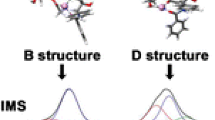Abstract
Oxaliplatin is an important anti-cancer drug that has been approved for the treatment of colorectal cancer. It is known that oxaliplatin, like other Pt-based drugs, interacts with DNA to form cytotoxic Pt-DNA adducts that disrupt important biological processes such as DNA replication and protein synthesis. Linear ion trap electrospray ionisation mass spectrometry (ESI-MS) was employed to study the interaction of oxaliplatin with DNA nucleobases. It was shown that oxaliplatin formed adducts with all four DNA nucleobases when present individually and in combination in solution. Multiple-stage tandem mass spectrometry (MSn) enabled the fragmentation pathways of each adduct to be established. In addition, proposed structures for each product ion were obtained from the MS data. When all four bases were present together with the drug at near-equal molar concentrations, adducts containing predominantly adenine and guanine were formed, confirming that the drug preferentially binds to these nucleobases. A large molar excess of drug was required to ensure the formation of cytosine and thymine adducts in the presence of adenine and guanine. Even with a large excess of oxaliplatin, only mono-adducts of these nucleobases were observed when all four nucleobases were present.

Schematic of a linear ion trap mass spectrometer being used to isolate the diadduct of guanine with oxaliplatin showing the characteristic isotope pattern due to 194Pt, 195Pt and 196Pt.









Similar content being viewed by others
Abbreviations
- Dach:
-
Diaminocyclohexane
- CID:
-
Collision-induced dissociation
- ESI-MS:
-
Electrospray ionisation–mass spectrometry
- GMP:
-
Guanine monophosphate
- A:
-
Adenine
- C:
-
Cytosine
- G:
-
Guanine
- T:
-
Thymine
References
Bell DN, Liu JJ, Tingle MD, McKeage MJ (2006) J Chromatogr B 837:29–34
Reedijk J (2003) Proc Natl Acad Sci USA 100:3611–3616
Ta LE, Espeset L, Podratz J, Windebank AJ (2006) Neurotoxicology 27:992–1002
Jamieson ER, Lippard SJ (1999) Chem Rev 99:2467–2498
Arnould S, Hennebelle I, Canal P, Bugat R, Guichard S (2003) Eur J Cancer 39:112–119
Almeida GM, Duarte TL, Steward WP, Jones GDD (2006) DNA Repair 5:219–225
Chaney SG, Campbell SL, Temple B, Bassett E, Wu Y, Faldu M (2004) J Inorg Biochem 98:1551–1559
Mandal R, Sawyer MB, Li X-F (2006) Rapid Commun Mass Spectrom 20:2533–2538
Woynarowski JM, Chapman WG, Napier C, Herzig MCS, Juniewicz P (1998) Mol Pharmacol 54:770–777
Rodger A, Patel KK, Sanders KJ, Datt M, Sacht C, Hannon MJ (2002) J Chem Soc Dalton Trans 3656–3663
Garcia Sar D, Montes-Bayón M, Blanco Gonzalez E, Sanz-Medel A (2006) J Anal Atom Spectrom 21:861–868
Timerbaev AR, Hartinger CG, Aleksenko SS, Keppler BK (2006) Chem Rev 106:2224–2248
Pluim D, Maliepaard M, Van Waardenburg RCAM, Beijnen JH, Schellens JHM (1999) Anal Biochem 275:30–38
Meczes EL, Azim-Araghi A, Ottley CJ, Pearson DG, Tilby MJ (2005) Biochem Pharmacol 70:1717–1725
Küng A, Strickmann DB, Galanski M, Keppler BK (2001) J Inorg Biochem 86:691–698
Luo FR, Yen T-Y, Wyrick SD, Chaney SG (1999) J Chromatogr B 724B:345–356
Spingler B, Whittington DA, Lippard SJ (2001) Inorg Chem 40:5596–5602
Wu YB, Pradhan P, Havener J, Cambell S, Chaney SG (2004) Abs Pap Am Chem Soc 228:U178
Yan X, Watson J, Shing Ho P, Deinzer ML (2004) Mol Cell Proteomics 3:10–23
Raji MA, Frycak P, Beall M, Sakrout M, Ahn J-M, Bao YP, Armstrong DW, Schug KA (2007) Int J Mass Spectrom 262:232–240
Iijima H, Patrzyc HB, Dawidzik JB, Budzinski EE, Cheng H-C, Freund HG, Box HC (2004) Anal Biochem 333:65–71
Iannitti-Tito P, Weimann A, Wickham G, Sheil MM (2000) Analyst 125:627–634
Le Pla RC, Ritchie KJ, Henderson CJ, Wolf CR, Harrington CF, Farmer PB (2007) Chem Res Toxicol 20:1177–1182
Shriver DF, Atkins PW, Langford CH (1994) Inorganic chemistry. Oxford University Press, Oxford
Author information
Authors and Affiliations
Corresponding author
Rights and permissions
About this article
Cite this article
Kerr, S.L., Shoeib, T. & Sharp, B.L. A study of oxaliplatin–nucleobase interactions using ion trap electrospray mass spectrometry. Anal Bioanal Chem 391, 2339–2348 (2008). https://doi.org/10.1007/s00216-008-2128-3
Received:
Revised:
Accepted:
Published:
Issue Date:
DOI: https://doi.org/10.1007/s00216-008-2128-3




